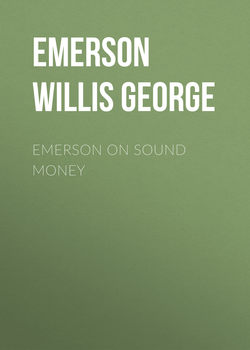Читать книгу Emerson on Sound Money - Emerson Willis George - Страница 8
GREENBACKS WERE CHEAP MONEY
ОглавлениеIn 1861 our country was engaged in civil war, and the greenbacks were issued as money, and were at once looked upon as a cheaper money than either gold or silver and immediately drove both gold and silver out of circulation and kept them out of circulation for seventeen years, or until we resumed specie payment in 1879. The history of these seventeen years is another instance where the cheaper money was victorious and drove out of circulation the higher priced money. Mr. Harvey no less than four times in his recent speech in this city gave the following definition of bimetallism: "Bimetallism is the right to use either of the two metals for money." This condensed answer bears about the same relation to the correct definition of bimetallism as the Boy Orator of the Platte compares with those intellectual giants whom he seeks to imitate, but without success, the immortal Washington and Lincoln. (Applause). Bimetallism as is understood in the discussion of our financial question, is the use of both gold and silver as money; both legal tender money, and the legal ratio between the two metals determined from the commercial ratio. Throughout Mr. Harvey's published works and lectures we find him affirming the false principle that money is a creature of law, and that by operation of law the commercial ratio between gold and silver can be made to conform with the legal ratio of 16 to 1. Let us follow the author of "Coin's Financial School" for a few moments, and see where this false principle will carry us.
